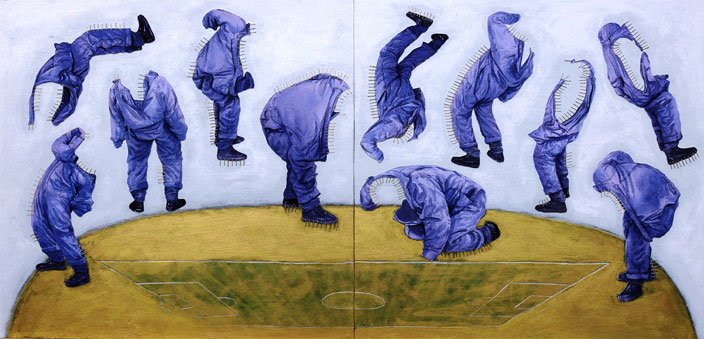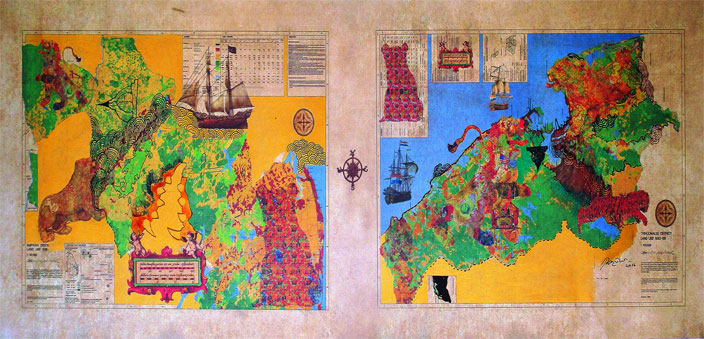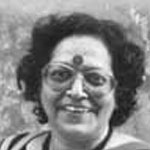Art is fluid, liquid and free-flowing, that refuses to be constricted by rules or confined to openings and closures. It has more fluidity than water which takes the shape of whatever vessel it is poured into. Art may transcend any enforced discipline of shape, form, style, texture, colour, line and dimension, and yet be able to stand on its own and make its own statement without uttering a single word. Art can be the most powerful form of self-expression for the artist who chooses his/her subject without subjecting himself/herself to any conditions at all, political, emotional or any other.
All this and much more came across in a recent exhibition held in Kolkata entitled Things Lost/Remembering the Future. It was a pan-South Asian exhibition that explored the ideas of loss, being, and regeneration through the lens of personal and public memory. The exhibition is the first of a series that hopes to open up new channels of communication and understanding, of the region’s unique political/historical reality, and its cultural sub-texts. Curated by artists Kurchi Dasgupta and Amritah Sen, Things Lost/Remembering the Future focuses essentially on the small, the forgotten, the misrepresented, as opposed to the official and the monumental. It looks upon the present from both the past and the future, and investigates the processes through which historical narratives habitually emerge. We hope it will allow an alternative perception of history to spill through, one that links the South Asian experience to the larger, Global South.
Every single artist whose work was put up at this group exhibition provided a lucid, literary explanation of the subject on display, and yet, as a viewer, knowledgeable or novice in understanding art, one was free to make one’s personal interpretation of the personal or the political or both, without referring to the written explanations at all and yet a meaning emerged from this appreciation.
The artistes and their art
Ashmina Ranjit of Nepal created a strange video where she walks back into the town she was once rooted to, and then had moved away to come back and find her past. She is constantly walking backwards which must have been a challenge unto itself because walking backwards especially when the camera is on, is not easy. According to Ashmina, “this video documents a metaphor that has been visualised and performed, one that captures what ‘Things Lost/Remembering the Future’ is invested in – silenced or lost memories, the personal and the small, and the many processes through which mainstream history emerges.” The work is intriguingly titled, “Same River, but the Water?” and that in itself opens up a new basket of questions for you.

Pala Pothupitiye of Sri Lanka had chosen to display two of his works at the exhibition. One was an ink-on-paper drawing titled Fractured Prosperity, while the other is named A Story of the Future from the Past, where he uses acrylic, pencil and ink and creates a digital print. The works are so finely etched that they offer a striking example of a blend of colour, fine lines, strokes and paints that divide the space into two equal parts, and make the total work appear like two beautifully worked out cartographical maps. Pala’s works have consistently commented on Sri Lankan politics while bringing us poignant images of the Sri Lankan experience that rises directly from its soil and culture. Raised within a thriving crafts tradition, Pala fuses it with his training in the Western tradition, and attacks our received notions of land, identity and culture.
Aye Ko is from Myanmar. His single piece of work Transfixed Look is a big digital photograph that repeats the same image of the same face with wide eyes looking through the bloodied, spread-out fingers of a hand. It carries the message of regimentation of troops blended into the horrific bloodiness of war. Aye Ko moved over from painting to performance and one guesses that that face and hand is his own as he wishes to use his own body as his subject in his works. According to the explanation, “He allows the political turmoil around him to inscribe itself upon his mind and body and channels his resistance to it through movement and performed action. In a country that is just beginning to open itself up to contemporary art, the fact that Aye Ko chooses to express himself through performance is in itself an act of resistance.”
Huma Mulji of Pakistan/UK had put up an astounding series on a once-upon-a-time breadmaker called Karamatullah. One is a colour photograph of Karamatullah, while one paper is almost blank with a caption given below perhaps to signify the complete disappearance of the manual breadmaker who baked 40 loaves of bread in his home, using a recipe that his father had used as an employee of the British army in pre-Independence and pre-Partition Pakistan (then India). In a frenzied, competitive market economy, his nameless bakery cannot compete, and he survives on belief, past glory, and a handful of faithful customers.
Says Huma, “The text and photos are based on our conversations over the years. Without spelling it out, he speaks of the pressure of the Cantonment Board, run by the Pakistan army, to close down the bakery. Karamatullah lives in an area which is now prime property, and his rundown little shop and house, is surrounded by posh homes, gifted to retired Army Generals. The work is a docu-fiction, based on ‘facts’ gathered from our conversations between 2009 and 2015.” This viewer interpreted this amazing series as a scathing critique on globalisation that has erased the existence and artistry of people like Karamatullah.

Maimoona Hussain of Maldives has placed two photographic expressions of two pieces of sculpture that express the lifelong mental torture that happens to a victim of child abuse. Hussain’s work is a digitally documented sculpture. One we thought had immense value, given the fact that she is speaking as a woman in Maldivian society, about the violence faced by women and the silence habitually imposed on them.
Some of the works are drawn from intimate and personal memories and experiences, while some memories are individual, but the creative comments have a collective impact. For example, there was one work by the Nepal-based performance artist who also works on art. His name is Sunil Sigdel. According to his own statement on Blue Slavery in Golden Construction, “It is an offering to those workers, who are labouring at the construction of the magnificent infrastructure and stadium for the upcoming 2022 World Cup. Recently, I did a performance on the subject in Moesgaard Museum, Denmark. I wore a labourer’s used, blue uniform and hooked a gold painted iron hammer (symbol of the World Cup Gold) that weighed six kgs on the back of my uniform. My body was bent backward and I was in physical pain.”
The eleven men dressed in blue workman’s overalls, without heads, bent differently across the canvas, with their backs stapled with golden pins stand out as a scathing indictment on the 2022 World Cup. It is a collage that “represents the workers as a football team that has lost the World Cup even before it has started off in Qatar.” It is a diptych. The entire work is adapted from the artiste’s personal performance and the missing heads reflect how the brains of the workers are chewed away, turning them not only into slaves but to human machines doctored to do as told. A beautiful exhibition the curators and the artists wish to take on a tour across the South Asian cities and countries.


 [/column]
[/column]